A major revision of the range in 1978 brought 1301cc
(78bhp) and 1585cc (96bhp) dohc engines - in the so called 'Super Mirafiori',
whilst the older sohc engines soldiered on in the 'Mirafiori' (the 1297cc
becoming 1301cc). Many changes included the bumpers, grille, lights (front
and rear), wheels, interior trim and several other items. The Super Mirafiori
was only available with four doors.
Also from 1978 the two door 131 Racing (Mirafiori
Sport in the UK) was built to capitalize on the rallying successes of the
131. This had the 1995cc engine from the 132 with
115bhp and a new front end with four round headlights and different grille.
Various minor mechanical changes were also made.
The third series was introduced in 1981 and featured
revised trim both externally and internally. The Mirafiori received sohc
engines 1367cc with 70bhp and 1585cc with 85bhp) whilst the Super
Mirafiori continued with the same powerplants (the Racing was discontinued
and the 1995cc unit went into a Supermirafiori). Other mechanical changes
included the clutch, gearbox, suspension, brake servo and engine mounts.
In the same year there appeared another variant, the 2000 Supermirafiori
Volumetrico Abarth. This had a 2 litre supercharged engine with 140bhp
and modified brakes, suspension, transmission etc.
The 131 was also built by SEAT in Spain.
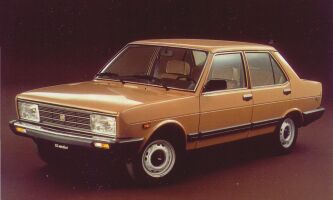 The
replacement for the 124, the 131 was introduced
in October 1974 in two, four & five (estate called 'Familiare') door
versions. In the US the 131 was sold as the 'Brava'. These first series
cars had the 1297cc and 1585cc ohv engines from the 124, with 65 and 75bhp
respectively, mounted longitudinally with a conventional rear wheel drive
layout. In 1976 the 131 Abarth was released, a modified two door car, with
a 1995cc 16V dohc engine with 140bhp. Around 400 were built for homologation purposes.
The
replacement for the 124, the 131 was introduced
in October 1974 in two, four & five (estate called 'Familiare') door
versions. In the US the 131 was sold as the 'Brava'. These first series
cars had the 1297cc and 1585cc ohv engines from the 124, with 65 and 75bhp
respectively, mounted longitudinally with a conventional rear wheel drive
layout. In 1976 the 131 Abarth was released, a modified two door car, with
a 1995cc 16V dohc engine with 140bhp. Around 400 were built for homologation purposes.
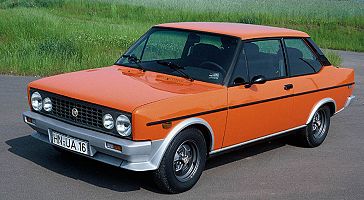 The estate was renamed 'Panorama' and two diesel engines (1995cc with 60bhp
and 2445cc with 72bhp) were also made available in both saloon and estate
bodyshells. The diesels were easily recognised by the large 'lump' in the
bonnet, necessary to clear the new engines, and by the pair of two round headlights.
The estate was renamed 'Panorama' and two diesel engines (1995cc with 60bhp
and 2445cc with 72bhp) were also made available in both saloon and estate
bodyshells. The diesels were easily recognised by the large 'lump' in the
bonnet, necessary to clear the new engines, and by the pair of two round headlights.
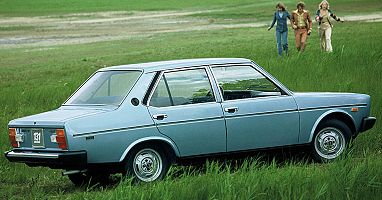 The 131 was also heavily modified by Abarth and used in the World Rally Championship,
a competition which it won in 1977, 1978 and 1980. This model featured
a 16V cylinder head, independent rear suspension (as on the 124
Abarth Spider) and numerous other changes for competition use.
The 131 was also heavily modified by Abarth and used in the World Rally Championship,
a competition which it won in 1977, 1978 and 1980. This model featured
a 16V cylinder head, independent rear suspension (as on the 124
Abarth Spider) and numerous other changes for competition use.
The following models were produced in each series
Series 1 : from 1974 :
Mirafiori 1297cc (65bhp) & 1585cc (75bhp)(both sohc)
Familiare 1297cc & 1585cc
Abarth 1995cc (140bhp) (dohc)
Series 2 : from 1978 :
Mirafiori 1301cc (65bhp)(sohc)
Supermirafiori 1301cc (78bhp) & 1585cc (96bhp) (both dohc)
Panorama 1301cc & 1585cc
Diesel 1995cc (60bhp) & 2445cc (72bhp)
Racing 1995cc (115bhp) (dohc) (known in the UK as Mirafiori Sport)
Series 3 : from 1981 :
Mirafiori 1367cc (70bhp) & 1585cc (85bhp) (both sohc)
Supermirafiori 1367cc (75bhp), 1585cc (97bhp) & 1995cc (113bhp) (all dohc)
Diesel 1995cc & 2445cc
Panorama 1301cc & 1995cc (petrol), 1995cc & 2445cc (diesel)
Volumetrico Abarth 1995cc (supercharged) (140bhp)
Total production (in Italy) of the 131 was 1,513,800.
Technical Details
| Driveline | longitudinal engine at front with rear wheel drive |
| Suspension | front : MacPherson strut with telescopic dampers and coil springs plus anti-roll bar
rear : live axle with telescopic dampers within coil springs, four forward links and Panhard rod wheelbase : 2490mm front track : MkI :1372mm; MkII & estate 1376mm (Abarth 1460mm) rear track : MkI : 1315mm; MkII & estate 1319mm (Abarth 1456mm) |
| Brakes | front : discs, diameter 227mm
rear : drums, diameter 228mm handbrake operating on the rear via a cable |
| Gearbox | 4 and 5 speed manual
3 speed automatic cable operated clutch |
| Steering | Rack and pinion
3.4 turns lock to lock |
| Engines | click here for details. |
| Kerb weight | 2 door : 965-975kg
4 door : 985-995kg Supermirafiori 1300/1600 : 1145kg; 2000 : 1175kg; 2500D : 1275kg |
| Dimensions | Mirafiori, Supermirafiori, Panorama & Abarth. |
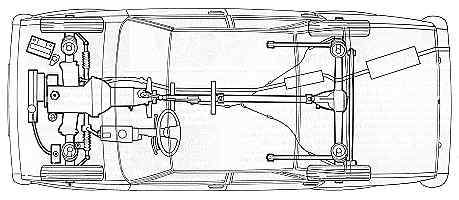 |
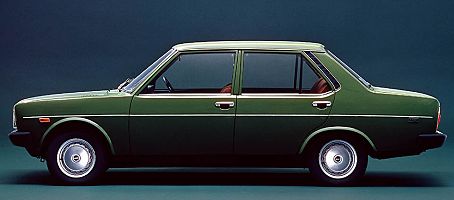 |
Performance
| model | max speed | 0-100km/h | standing km | braking dist from 100km/h |
| 131 1300CL (1301cc sohc) | 150 km/h | 14.9 sec | 36.58 sec | 56.2 m |
| Supermirafiori 1300TC | 159 km/h | 12.5 sec | 34.6 sec | 54.2 m |
| Supermirafiori 1600TC | 167 km/h | 10.5 sec | 32.8 sec | 54.2 m |
| Supermirafiori 2000TC | 176 km/h | 9.9 sec | 31.9 sec | 54.9 m |
| Supermirafiori 2500 D | 146 km/h | 17.8 sec | 38.4 sec | 53.5 m |
Tuning
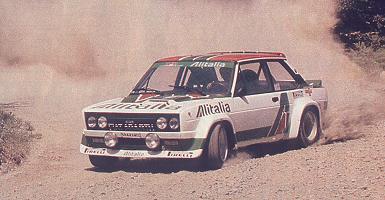 Winning
three World Rally Championship titles proved that the 131 was capable of
modification to the highest level. Unfortunately for most of us some of
the major rallycar modifications are probably out of reach (independant
rear suspension, 16V cylinder head, lightweight bodypanels), but there
are still a number of effective changes worthwhile.
Winning
three World Rally Championship titles proved that the 131 was capable of
modification to the highest level. Unfortunately for most of us some of
the major rallycar modifications are probably out of reach (independant
rear suspension, 16V cylinder head, lightweight bodypanels), but there
are still a number of effective changes worthwhile.
There are three main areas to concentrate on, the engine (and transmission), the brakes and the suspension and then various other details. These three should be done together since they complement each other, not all of one and none of another !
1. The engine.
Before modifying the engine it is worthwhile filling it with a good quality synthetic oil and fitting new spark plugs. An engine oil additive may also be used.
The first improvements are relatively simple. The air filter can be replaced for an aftermarket item which will help the engine breathe more freely and the exhaust can be replaced for one which will restrict the exit of the gases less.
The main modification (outside of taking the engine apart) is to fit a better carburettor. For the sohc versions, twin downdraught DCNFs are possible, whilst for the twin cams 45 DCOE's are a good choice (40's on a 1600). Downdraught setups are also possible, but the sidedraught one is to be preferred. A camshaft will also provide a noticeable gain, especially if fitted in conjuction with the carburettor.
Other things to do should include fitting a cold
air intake, a large diameter pipe (minimum 5cm) to provide air from outside
the engine bay to the air filter. The exhaust manifold can also be lagged
with thermal cloth or tape to keep the exhaust gases hotter (and thus reduce
back pressure) and also to keep the underbonnet (and hence intake and fuel) temperatures lower.
Regarding the transmission the main requirement is
to uprate the clutch to handle the increase in power and torque achieved
though the engine modifications. Friction plates can be purchased with
improved materials and heavier duty pressure plates are also available.
Whilst doing this it is worthwhile lightening the flywheel.
The high tension leads can also be replaced with performance ones.
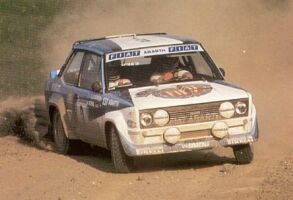 Further
modifications require the machining of the cylinder headand/or cylinder
block (which will not be dealt with here since it is not normally a DIY
job) after which it may be worth fitting an oil cooler. If overheating
is a problem due to the increased power output then a small hole can also
be drilled through the plate in the thermostat. There are a multitude of
company's with experience of internal cylinder head modifications for the
FIAT twin cam engine, and a 1995cc engine with 45 DCOE's and a gasflowed
head should produce over 150bhp.
Further
modifications require the machining of the cylinder headand/or cylinder
block (which will not be dealt with here since it is not normally a DIY
job) after which it may be worth fitting an oil cooler. If overheating
is a problem due to the increased power output then a small hole can also
be drilled through the plate in the thermostat. There are a multitude of
company's with experience of internal cylinder head modifications for the
FIAT twin cam engine, and a 1995cc engine with 45 DCOE's and a gasflowed
head should produce over 150bhp.
2. The brakes.
Initially it is relatively easy to replace the brake
discs with drilled and grooved items, and the pads for a harder compound.
The latter should not be too hard (ie no race pads on the road) or they
will not function effectively at the normal 'road' operating temperatures.
Stainless steel braided flexible hoses will improve the pedal feel and
reduce the chance of damage whilst DoT5 fluid (not silicon) will increase
the temperature at which it can operate effectively. If the brakes are
getting too hot the dustguards can be removed and/or ducts fitted, taking
air from behind the front bumper.
If more serious braking is required the next modification
would be to increase the disc size. It is possible to use larger discs
with a bracket allowing use of the production callipers, or alloy four
pot callipers can be fitted.
In order to improve the balance of the car under
braking it is desireable to be able to adjust the balance of braking from
front to rear (and vice versa). This can be accomplished by fitting a bias
valve in the line to the rear brakes, usually in a position so that it
can be reached from the drivers seat.
3. The suspension.
The easiest improvement,and the one which will probably
bring the single most noticeable change, is to replace the dampers and
springs. Fitting lowered springs will improve the cornering, but must be
fitted together with shortened throw dampers, or else the There are then two other main suspension aims; to
reduce the flexiblity in the suspension and to increase the stiffness of
the car, both of which aim at more accurate control of the wheel movement.
To reduce the flexibility it is possible to fit nylon bushes instead of
the normal production rubber items, or if perfection is desired the suspension
can be fitted with metallic bearings (rose joints / rod ends). Spherical
bearing top mounts can also be used. To stiffen the car it is most popular
to fit strut braces. These can be fitted to the front and rear. For more
extreme cases a rollcage can be fitted.....
Into this category also fall the choice of wheels
and tyres. With an increase in power it can be necessary to fit larger
tyres (thus requiring larger wheels) but the temptation to fit the biggest
possible should be resisted. Consideration should be given to fitting a
wider tyre on the rear (since they provide traction) but keeping the standard,
or a wider but not as wide as the rear, tyre at the front. This will improve
the balance of the car and not make the steering too heavy.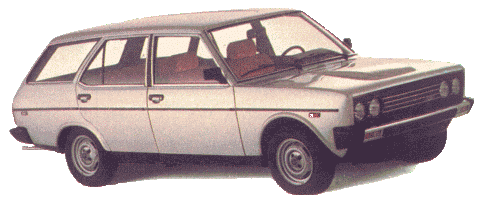 springs
may unseat ! Top adjustable dampers are compromised, but are good for road
and track day cars since it allows the suspension to be adjusted between
these two, rather different, requirements. Coil over units add more adjustability
and can be purchased outright, or can be made from standard dampers by
welding a threaded sleeve to the standard tube.
springs
may unseat ! Top adjustable dampers are compromised, but are good for road
and track day cars since it allows the suspension to be adjusted between
these two, rather different, requirements. Coil over units add more adjustability
and can be purchased outright, or can be made from standard dampers by
welding a threaded sleeve to the standard tube.
4. other things.
Other modifications worth considering include fitment of a shift light (and rev limiter if there is not one as standard), higher power bulbs in the headlights (if you are going to go faster you need to see further) and installation of a quicker steering rack.
Maintenance
If you have just purchased a second hand car then it is recommended to change the timing belt ! And use an original FIAT one, not some cheap copy.
Buying / Selling
131's are now quite rare - most having succumbed to the dreaded tin worm. Those that remain are mostly enthusiasts cars and have thus been well treated. Prices are accordingly higher than 'any old "old car" '. There are still the basics, however, which always apply....
Some tips to do before selling : (they may
seem obvious, but most people don't do them and thus are in a weaker bargaining position).
If the car has been standing give it a good run -
this will clear out the engine (reduce exhaust smoke), put a shine on the
brake discs and loosen up any joints that may otherwise make some noises.
'Back to black' products are very effective at temporarily
restoring bumpers and trim. This makes a big difference to any car. Do
it a week before you expect people to view the car, otherwise it may be
a bit too obvious !
Jetwash under the car, especially under the engine
and in the wheelarches. The prospective buyer may be an enthusiast (particularly
likely with the 131), and this makes it easier for them to see what they
want to check.
Obviously wash the car and clean the windows !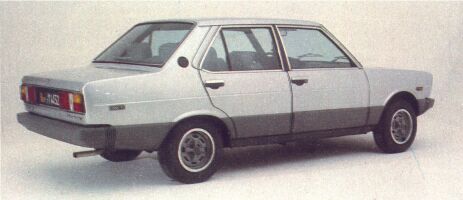 Tidy
inside the car thoroughly : hoover the floor, empty all pockets, ashtrays
(wash), glove compartment etc..., wipe the trim with a damp cloth, give
the cockpit a good airing to get rid of any odours ! Reset the trip meter
to 00000 - it is a pleasant (subconcious) surprise.
Tidy
inside the car thoroughly : hoover the floor, empty all pockets, ashtrays
(wash), glove compartment etc..., wipe the trim with a damp cloth, give
the cockpit a good airing to get rid of any odours ! Reset the trip meter
to 00000 - it is a pleasant (subconcious) surprise.
If you are going to buy a car always check the following :
Check for a damp carpet or the presence of mould
- if the carpet is damp then the floor is almost certainly corroded.
Check the main electrical functions - wipers, lights,
etc... try putting the main beam and wipers on at the same time. Check
the headlight reflectors for rust.
Check the brake pedal does not go to the floor if
pressed hard for a long time and check the gearchange for clean engagement.
Check tyre wear, uneven patterns could imply a bent chassis.
Always take it for a test drive. Check that the car
tracks in a straight line with no steering input and also remains straight
under braking. Find a large open area and complete several lock to lock
turns (also in reverse), listening for any noises. Try the handbrake when
moving - seized rear callipers will mean uneven braking or no braking.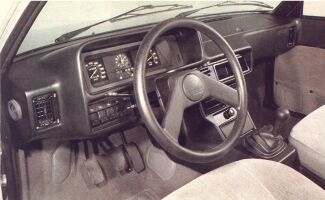 Firstly check the bodywork. Pay special attention
to the wheelarches (inside if there is no plastic splash guard), suspension
and engine mounts, sill, door pillars (check for sagging doors), scuttle
panel and the floor (doors, bonnet and boot/hatch are also susceptible,
but are more easily replaced). If a sunroof is fitted check around the
edge for signs of rust. Check that there are no mismatching
panels, large areas of discolouration or signs of fresh paint (compare
inside the engine bay with the external body colour), all of which probably
indicate accident damage.
Firstly check the bodywork. Pay special attention
to the wheelarches (inside if there is no plastic splash guard), suspension
and engine mounts, sill, door pillars (check for sagging doors), scuttle
panel and the floor (doors, bonnet and boot/hatch are also susceptible,
but are more easily replaced). If a sunroof is fitted check around the
edge for signs of rust. Check that there are no mismatching
panels, large areas of discolouration or signs of fresh paint (compare
inside the engine bay with the external body colour), all of which probably
indicate accident damage.
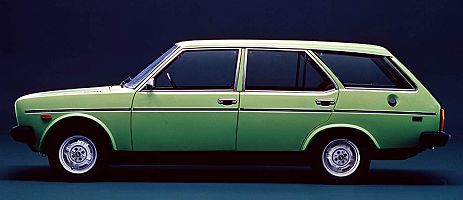 The engine should be run up to temperature, check
the exhaust for smoke, the condition of the breather (look for mayonnaise),
the condition of the oil filler cap (again white deposits can indicate
head gasket or other serious problems or the use of the car only on short
journeys, another bad state of affairs) and the colour of the coolant (preferably
not thick or dark brown!). Listen to the noise of the engine, then depress
the clutch and engage first gear. Whatever noise has disappeared was coming
form the gearbox, what remains is from the engine. Also check the condition
of the engine oil on the dipstick.The lighter brown the better, if it is
thick black then leave quickly.
The engine should be run up to temperature, check
the exhaust for smoke, the condition of the breather (look for mayonnaise),
the condition of the oil filler cap (again white deposits can indicate
head gasket or other serious problems or the use of the car only on short
journeys, another bad state of affairs) and the colour of the coolant (preferably
not thick or dark brown!). Listen to the noise of the engine, then depress
the clutch and engage first gear. Whatever noise has disappeared was coming
form the gearbox, what remains is from the engine. Also check the condition
of the engine oil on the dipstick.The lighter brown the better, if it is
thick black then leave quickly.
For books on the Fiat 131 see our Online Bookstore
131 comment form
Your Comments
I purchased a 1981 131 Superbrava Series
1 when I was 20 Years old, a pretty insane choice considering a FIAT's
reputation. But I have learnt that these little cars have a solid unburstable
feel and a sense of quality that is not matched by anything else in its
age group. This is coupled with the sporty intent of it's two litre DOHC,
it's handling leaning towards the precise, and its strange at first but
definately comfortable and supportive seating. If you are willing to put
in a little effort towards maintaining it, a 131 is definetely a step in
the right direction.(John, Australia)
My first car was a 1980 Fiat 131 Racing.
It was a really hot car in the street. Fortunately, in my country there
are many examples of 131's which were produced locally, so we have nice
tuned and modified Mirafiories in Istanbul. (Dandano, Turkey)
Great handling cars, esp. with the next generation rack and pinion steering. 2 litre models go like the wind when tuned properly. Shame about the cheap plasticy interiors which fall to bits in no time.
(El Stevo, New Zealand)
It's very nice in this color. I wish there were one for sale!! I had the AzuroBlue (or something, blue metallic anyway!). Also very nice color, and I wish I kept it instead of trashing it =o(
Young and ignorant! *Sigh*
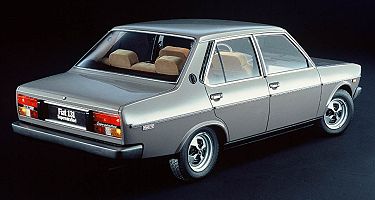 Had a 131 supermiafiori. 2000cc. Outstanding!!! (Tord)
Had a 131 supermiafiori. 2000cc. Outstanding!!! (Tord)
Wallpapers/Desktop Backgrounds of the 131 also available to download.
There is also a list of all our picture galleries (including museums, motorshows and various events).
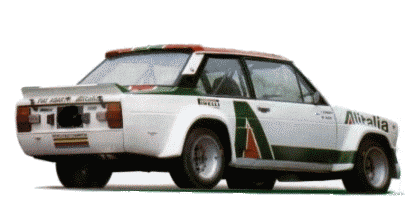
Use the buttons at the top to navigate further, or
Copyright © 2000 to 2008 CarsfromItaly